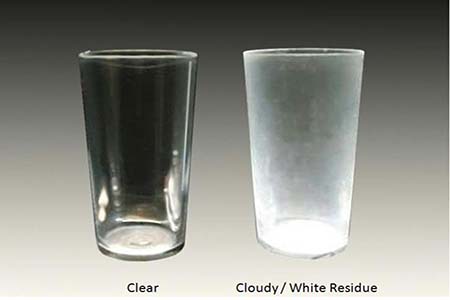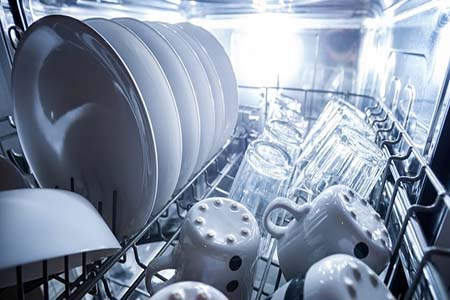In this comprehensive guide, we will delve into the reasons behind white residue on your dishes and provide practical solutions to help you achieve spotless and gleaming results from your dishwasher.
Common Causes of White Residue

1. Hard Water Buildup
- One of the most prevalent causes of white residue on dishes is hard water. When your dishwasher uses hard water for cleaning, minerals like calcium and magnesium can accumulate on your dishes, leaving behind the chalky residue you see. This problem tends to be more pronounced in areas with high water hardness.
2. Improper Detergent Usage
- Using the wrong type of detergent or not using enough can lead to white residue issues. Dishwashing detergents contain enzymes and surfactants designed to break down and remove food particles and grease. If you’re using the wrong detergent or not using enough of it, the detergent might not effectively eliminate residues, leading to cloudy dishes.
3. Rinse Aid or Detergent Overuse
- On the flip side, overusing rinse aid or detergent can also cause problems. These products are formulated to be used in specific amounts. When you exceed the recommended dosage, they can leave behind a sticky film or white streaks on your dishes.
4. Dishwasher Overloading
- Overloading your dishwasher can impede water circulation during the wash cycle. This lack of proper water flow can result in inadequate rinsing and detergent residue being left on your dishes. So, loading your dishwasher beyond its capacity may lead to white residue problems.
Steps to Diagnose the Issue
Now that we’ve identified some common causes, let’s explore how to diagnose and address the issue effectively:
- Inspect Your Water Supply: Begin by checking the hardness of your water supply. You can do this by contacting your local water utility or using water hardness test strips available at many hardware stores. If you have hard water, consider installing a water softener to reduce mineral buildup.
- Examine Your Detergent and Rinse Aid: Ensure you’re using the right type of dishwasher detergent for your water hardness. Check the detergent’s packaging for recommendations. Also, use the recommended amount. Adjust the detergent dosage according to your dishwasher’s load size and water hardness.
- Check Dishwasher Loading: Review your dishwasher loading practices. Avoid overloading the dishwasher, as this can inhibit proper water circulation and lead to residue problems. Dishes should be spaced to allow water and detergent to reach all surfaces.
- Inspect the Dishwasher’s Components: Regularly inspect your dishwasher’s components, including spray arms, filters, and nozzles. Clean any clogs or blockages that could disrupt the water flow during the wash cycle. A well-maintained dishwasher is more likely to produce spotless results.
Solutions for Removing White Residue

- Vinegar Rinse:
- Vinegar is a natural acid that can help dissolve and remove white residue from your dishes. To use this method:
- Place a dishwasher-safe cup or bowl filled with white vinegar on the top rack of your empty dishwasher.
- Run a hot water cycle, but skip the drying cycle. The vinegar will work during the wash cycle to remove residue.
- Baking Soda Soak:
- Baking soda is an excellent abrasive cleaner that can help scrub away white residue. Here’s what to do:
- Sprinkle a layer of baking soda on the bottom of your dishwasher.
- Place your white-residue-covered dishes in the dishwasher as usual.
- Run a short cycle with hot water. The baking soda will help scrub the dishes clean.
- Rinse Aid Adjustment:
- Ensure you’re using rinse aid in your dishwasher. Rinse aid helps prevent residue and water spots by promoting better rinsing. Check your dishwasher’s user manual for instructions on adjusting the rinse aid settings.
- Switch to a Different Detergent:
- If you suspect that your detergent is the culprit, try switching to a different brand or type of detergent. Opt for one that is specifically designed for hard water if that’s an issue in your area.
- Increase Water Temperature:
- Hotter water can help dissolve and remove residue more effectively. Check your dishwasher’s water heater settings and make sure it’s set to a sufficiently high temperature for effective cleaning.
- Manual Dishwashing:
- If the residue is persistent, you can try hand washing the affected dishes with warm, soapy water. Use a scrub brush or sponge to gently remove the residue. Rinse thoroughly and dry.
- Professional Inspection:
- If you’ve tried all the above methods and the white residue problem persists, consider consulting a professional dishwasher repair technician. There may be an issue with the dishwasher’s components or water supply that requires expert attention.
Regular maintenance
Regular maintenance is key to preventing white residue on your dishes. Here are some essential maintenance tasks to include in your routine:
- Clean the Filter: Your dishwasher has a filter that traps food particles and debris. Over time, this filter can become clogged, reducing the dishwasher’s efficiency. Consult your dishwasher’s manual for instructions on how to remove and clean the filter. In most cases, it can be easily rinsed under running water.
- Inspect Spray Arms: The spray arms in your dishwasher are responsible for distributing water and detergent to your dishes. Check them for clogs or obstructions regularly. Remove any debris that may be blocking the spray arms, as this can hinder proper cleaning.
- Check Water Temperature and Pressure: Ensure that your dishwasher is receiving an adequate supply of hot water at the right pressure. Water temperature is crucial for activating the detergent and cleaning effectively. If you suspect an issue with your hot water supply, consult a plumber.
Pre-Rinsing Dishes
While modern dishwashers are designed to handle dirty dishes, heavy food residue can still lead to white residue issues. To prevent this, consider lightly rinsing dishes before loading them into the dishwasher. Here are some pre-rinsing tips:
- Scrape Off Excess Food: Use a spatula or paper towel to remove excess food scraps from your dishes. This will prevent large food particles from clogging the filter or spray arms.
- Avoid Excessive Pre-Rinsing: While it’s a good practice to remove heavy food residues, avoid excessive pre-rinsing. Dishwasher detergents are formulated to work effectively in the presence of some food particles. Excessive rinsing can reduce detergent effectiveness and lead to poor cleaning results.
Using Vinegar or Baking Soda
Vinegar and baking soda are natural and effective solutions for preventing and removing white residue:
- Vinegar: Place a cup of white vinegar on the top rack of an empty dishwasher and run a hot water cycle. Vinegar helps dissolve mineral deposits and detergent buildup in your dishwasher, leaving it clean and ready to tackle future loads.
- Baking Soda: Sprinkle a small amount of baking soda in the bottom of your dishwasher before starting a wash cycle. Baking soda is an excellent natural cleaner that can help break down residues and odors inside the dishwasher.
Using these natural remedies periodically can help maintain the cleanliness of your dishwasher and prevent white residue from building up.
Consult a Professional If you’ve tried all the DIY solutions and still face persistent white residue problems, it may be time to consult a professional dishwasher technician. Some issues, such as a malfunctioning water softener, clogged water jets, or a faulty detergent dispenser, may require expert diagnosis and repair. A professional technician can ensure that your dishwasher operates optimally, leaving your dishes spotless after every cycle.